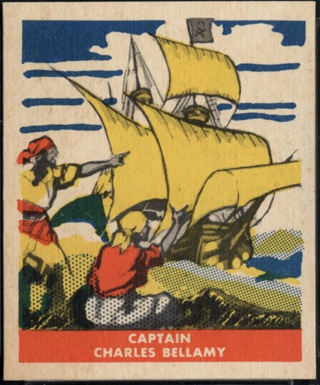
Bartholomew Roberts, born John Roberts, was a Welsh pirate who was, measured by vessels captured, the most successful pirate of the Golden Age of Piracy. During his piratical career, he took over 470 prize ships. Roberts raided ships off the Americas and the West African coast between 1719 and 1722; he is also noted for creating his own Pirate Code, and adopting an early variant of the Skull and Crossbones flag.

John Rackham, commonly known as Calico Jack, was an English pirate captain operating in the Bahamas and in Cuba during the early 18th century. His nickname was derived from the calico clothing that he wore, while Jack is a nickname for "John".
Captain Benjamin Hornigold (1680–1719) was an English pirate who operated during the tail end of the Golden Age of Piracy.

Stede Bonnet was a Barbadian-born pirate and military officer, known as the Gentleman Pirate for the reason that he was a moderately wealthy landowner before turning to a life of crime. Bonnet was born into a wealthy English family on the island of Barbados, and inherited the family estate after his father's death in 1694. Despite his lack of sailing experience, Bonnet decided he should turn to piracy in the winter of 1716 or spring of 1717. He bought a sailing vessel, the Revenge, and travelled with his paid crew along the Eastern Seaboard of what is now the United States, capturing other vessels and burning other Barbadian ships.

Walking the plank was a method of execution practiced on special occasion by pirates, mutineers, and other rogue seafarers. For the amusement of the perpetrators and the psychological torture of the victims, captives were bound so they could not swim or tread water and forced to walk off a wooden plank or beam extended over the side of a ship.

Edward "Ned" Low was a notorious pirate of English origin during the latter days of the Golden Age of Piracy, in the early 18th century. Low was born into poverty in Westminster, London, and was a thief from an early age. He moved to Boston, Massachusetts, as a young man. His wife died in childbirth in late 1719. Two years later, he became a pirate, operating off the coasts of New England and the Azores, and in the Caribbean.

Charles Vane was an English pirate who operated in the Bahamas during the end of the Golden Age of Piracy.

Charles Bellamy was an English pirate who raided colonial American shipping in New England and later off the coast of Canada. He is often confused with the more well-known Samuel "Black Sam" Bellamy, as they operated in the same areas at the same time.

A General History of the Robberies and Murders of the most notorious Pyrates, or simply A General History of the Pyrates is a 1724 book published in Britain containing biographies of contemporary pirates, which was influential in shaping popular conceptions of pirates. Its author uses the name Captain Charles Johnson, generally considered a pen name for one of London's writer-publishers. The prime source for the biographies of many well-known pirates, the book gives an almost mythical status to the more colourful characters, and it is likely that the author used considerable artistic license in his accounts of pirate conversations. The book also contains the name of the pirate flag the Jolly Roger and shows the skull and bones design.

John Evans was a Welsh pirate who had a short but successful career in the Caribbean.

Richard Worley was a pirate who was active in the Caribbean Sea and the East Coast of the American Colonies during the early 18th century.
See also 1717 in piracy, 1719 in piracy, and Timeline of piracy.

John Martel was a French pirate active in the Caribbean.
Richard Shipton was a pirate active in the Caribbean, best known for sailing alongside Edward Low and Francis Spriggs. In 1723 Shipton was elected captain of Merry Christmas, and he subsequently captained ships such as Royal Fortune, York, and John and Mary. Forced to beach his vessel on western Cuba by pirate hunters, in early 1726, he was found ashore in his bed and presumed to have died shortly afterwards.

Philip Lyne was a pirate known for his cruelty and his association with Francis Spriggs.
William Mayes was a pirate active in the Indian Ocean. He was best known for taking over William Kidd’s ship Blessed William and sailing with Henry Avery.
Thomas White was an English pirate active in the Caribbean and the Indian Ocean. He was only briefly a captain on his own, but served under several more prominent captains such as George Booth, John Bowen, Thomas Howard, John Halsey, and Nathaniel North.
John Cole was a pirate active off the American eastern seaboard. His brief career is associated with Richard Worley and William Moody. He is known more for the unusual cargo of his pirate ship than for his piracy.
John Cornelius was an Irish pirate allegedly active in the Red Sea and off the west coast of Africa. He succeeded William Lewis, who was killed after announcing he had made a deal with the Devil. Lewis and Cornelius are likely the fictional creations of Captain Charles Johnson, who presented their stories among those of real historical pirates.
David Williams was a Welsh sailor who turned pirate after being abandoned on Madagascar. He was only briefly a captain, and is best known for sailing under a number of more prominent pirate captains.














